We examined nearly 1000 images shortlisted for Astronomy Photographer of the Year and we have pulled out the data to identify the Best Nikon Cameras for Astrophotography.
See the quick links below or read on to see all the data and for more information.
|
Make & Model:
Nikon Z6 II
|
Make & Model:
Nikon Z7 II
|
Make & Model:
Nikon Z6 III
|
|
Type:
Mirrorless
|
Type:
Mirrorless
|
Type:
Mirrorless
|
|
Sensor:
Full-frame
|
Sensor:
Full-frame
|
Sensor:
Full-frame
|
|
Sensor size:
24.5 MP
|
Sensor size:
45.7 MP
|
Sensor size:
24.5 MP
|
Best Nikon for Astrophotography
In our research to find the best camera for nightscape photography, we analyzed 986 images shortlisted in the past seven years for the world’s most prestigious annual astrophotography competition – Royal Museums Greenwich Astronomy Photographer of the Year.
Over the seven years, 162 shortlisted images were taken with Nikon cameras and 19 different models have been used.
In the past two years, there are three models in particular that are way out in front. These are the:
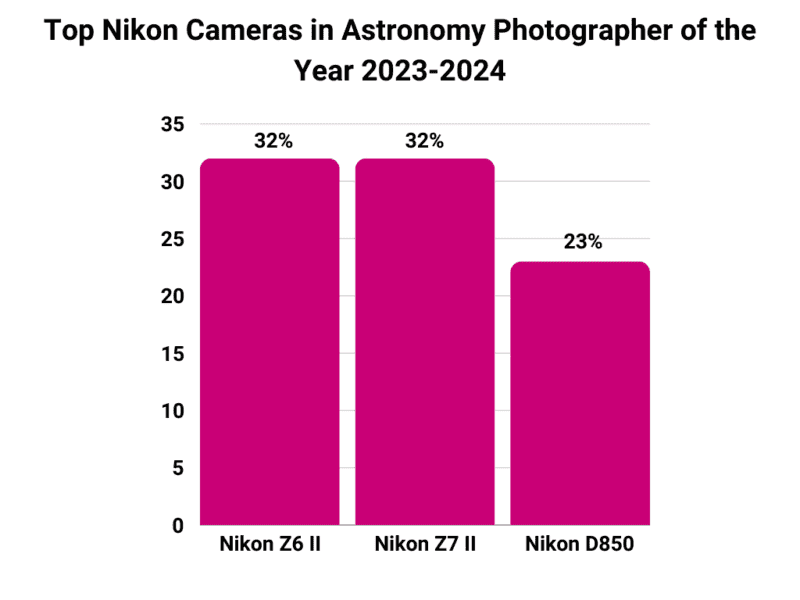
If we look at the data for the whole seven years covering 2018 to 2024 then these are the top models:
- Nikon D850 – 20%
- Nikon D750 – 17%
- Nikon Z6 II – 13%
- Nikon D810A – 12%
- Nikon Z7 II – 11%
- Nikon D810 – 9%
DSLR vs Mirrorless
The reason that we have isolated the last two years above is that in the past few years there has been a big shift from people using DSLRs like the D850 and D750 to using the newer mirrorless models like the Z6 II and Z7 II.
This is not just the case with Nikon cameras, but also with wider photography.
If you look at our data analysis you can see that this shift occurred around 2022 and has continued since.
The reason we have included the Nikon Z6 III in our top recommendations is that it is a brand new 2024 upgrade and so should appeal to those that want the latest model even though it won’t show up in our astrophotography competition data as it is too new.
Full Frame vs APS-C
One thing to note is that the best cameras for landscape astrophotography all have full-frame sensors:
- Full frame sensors are better in low light conditions (like night sky photography)
- Have a wider field of view which is best for landscape astrophotography where you want to capture as wide an expanse of night sky as possible
This is why all the cameras that we recommend in this article are full-frame models.
The downside is that they are more expensive.
You can obviously use an APS-C crop sensor camera for astrophotography but – as this data suggests – if you want to have the best tool in your hands then it should be a full-frame model.
Let’s look now at each of our recommended models.
Nikon Z6 II
Top Pick / Best Value
Our top recommendation for the best value Nikon camera for astrophotography in 2025 is the Nikon Z6 II.
Nikon came out with the Z6 and Z7 in 2018, but then updated them both in 2020 with the Mark II versions to fix a number of practical issues that people had with the first iterations.
The Z6 and Z6 II have the same sensor but among the upgrades are two features that are particularly good for astrophotography:
- The Z6 II allows you to take long exposures of up to 15 minutes without using an external intervalometer, whereas the original Z6 has this capped at 30 seconds, which is quite limiting for long-exposure photography in low light.
- When you turn the Z6 II off and back on again it remembers your last focus settings. This is great if you are using it mostly for astrophotography and want to be able to pick up where you left off on a previous night.
Therefore it is worth going for the Z6 II if you have the budget, but you can save some money by going for the older version and living without the above tweaks (the first point is remedied by using an intervalometer).
The Z6 II is lower resolution than the Nikon Z7 II but is substantially cheaper and proven for astrophotography so it makes our top recommendation.
Note, if interested you can also buy pre-astro modified versions of the Z6 II here.
Full frame Mirrorless Interchangeable Lens Camera
- Great new mirrorless from Nikon
- Proven astrophotography performance
- Mid-range price
- Lower resolution than the Z7 II
Nikon Z7 II
Premium Pick
If you have the budget and want higher megapixels, then the Nikon Z7 II might be your preferred option.
You can see from our data above that it is the equal most successful Nikon model for astrophotography.
It is very similar to the Z6 II above but has a higher resolution sensor, which is why it costs more.
Full Frame Interchangeable-Lens Mirrorless Camera
- Full-frame sensor
- 45.7 MP resolution
- Premium all-round camera that is proven for astrophotography
Nikon Z6 III
Brand new
For those that want the latest and greatest, then the brand new Nikon Z6 III is probably for you.
It features all the positives of the Z6 II but also some other advantages such as Starlight Mode (which was first featured on the much pricier Nikon Z8).
Starlight Mode is specifically designed for low-light photography (e.g. astrophotography) and provides a brightened image on the live view screen to help with focusing and composing your image.
The Z6 III also has a flip-out vari-angle touchscreen, as opposed to the tilting screen of the Z6 II. This can be helpful when composing images at awkward heights and angles, as is sometimes required to get the desired composition.
There is a good article here outlining all the differences between the Z6 II and the Z6 III. Most of the others are irrelevant for astrophotography, but you may find them desirable if you want to use the camera for other purposes as well.
FX-Format Mirrorless Camera
- Brand new in 2024
- The latest and greatest version in Nikon's Z6 series
- Starlight View mode to aid focusing and composition for night sky photography
- 24.5 MP full-frame sensor
- Fairly expensive
- Lower resolution than the Z7 II
Nikon D810A
The only Nikon Astrophotography-Modified Camera
Lastly, we need to mention the Nikon D810A as it is the only Nikon camera specifically optimized for astrophotography (the “A” is for astrophotography).
This means that it has had its sensor adjusted so that it doesn’t filter out specific types of light that are emitted by objects in deep space – any normal DSLR filters this out. The result is that astrophotography images taken with this camera.
You cannot buy it new anymore, but you may be able to find it used (click the buttons below to check).
Astrophotography Modified DSLR Camera
- Employs an optical IR cut filter with specific transmission characteristics (characteristics in the 656nm range), enabling the capture of nebulae and distant galaxies that emit H-alpha wavelength in red
- 36.3MP FX-format CMOS sensor
- Virtual preview for more accurate focusing and composition for exposure longer than 30 seconds
What’s the Best Nikon Camera for Astrophotography?
To recap, our recommendations using our unique data are:
- Top Pick / Best Value – Nikon Z6 II
- Premium Pick with higher resolution – Nikon Z7 II
- Brand New Pick for 2025 – Nikon Z6 III
- Astro-Modified Pick – Nikon D810a
One final thing to note is that many of the most successful astrophotographers use astro-modified models.
These are regular Nikon cameras but they have paid to have the sensors altered to make them better for astrophotography by capturing a greater range of light.
This is great if you are really serious and you only want to use the camera for astrophotography and not other daytime use.
You can check prices and availability to buy pre-astro modified versions of the Z6 II here.


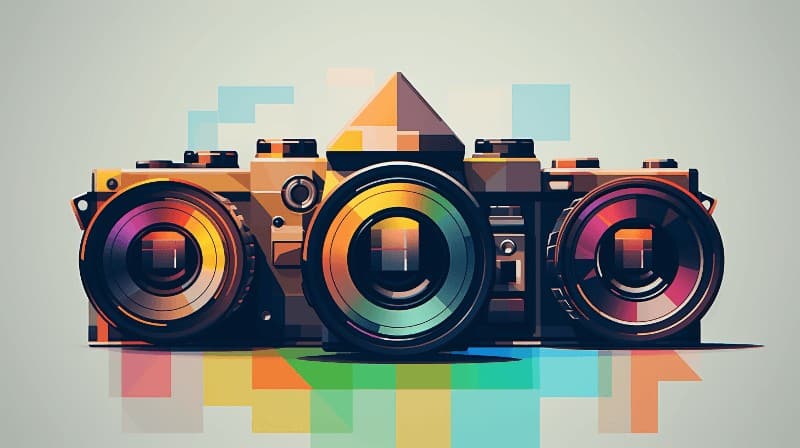
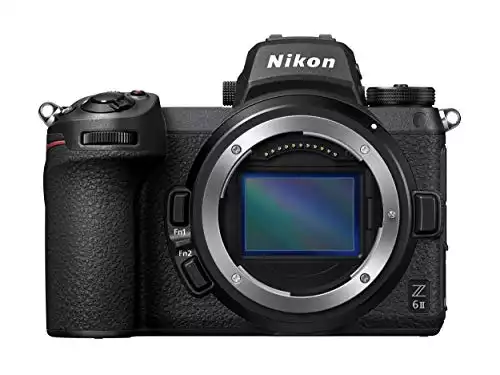
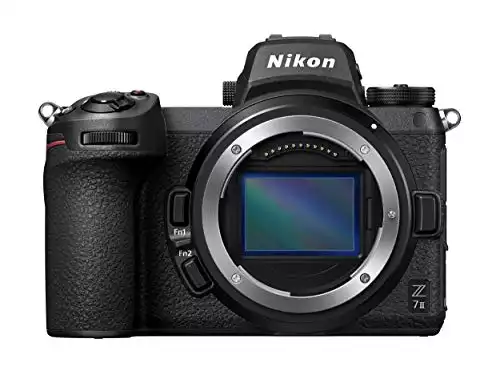
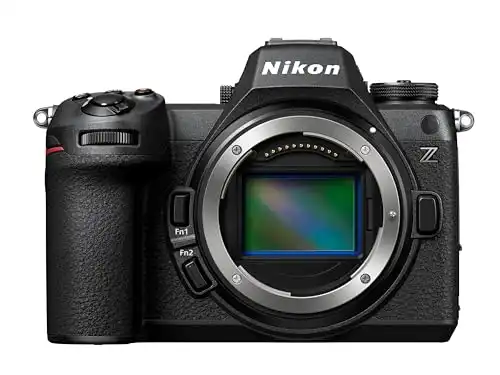
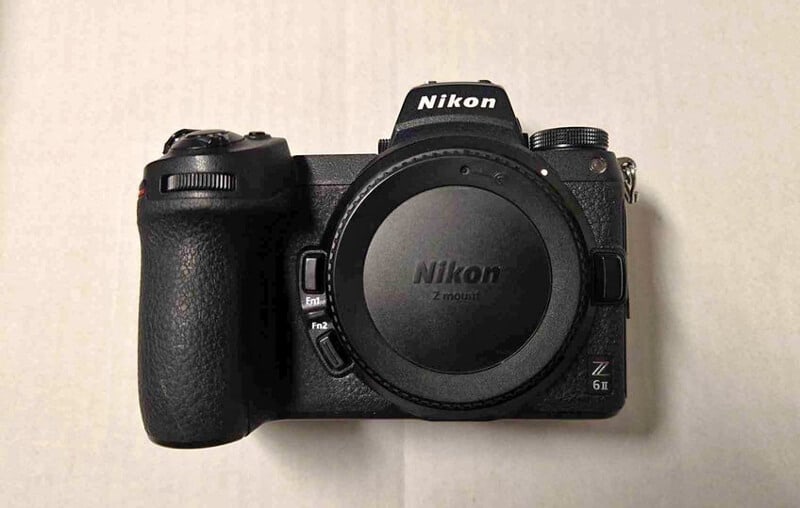

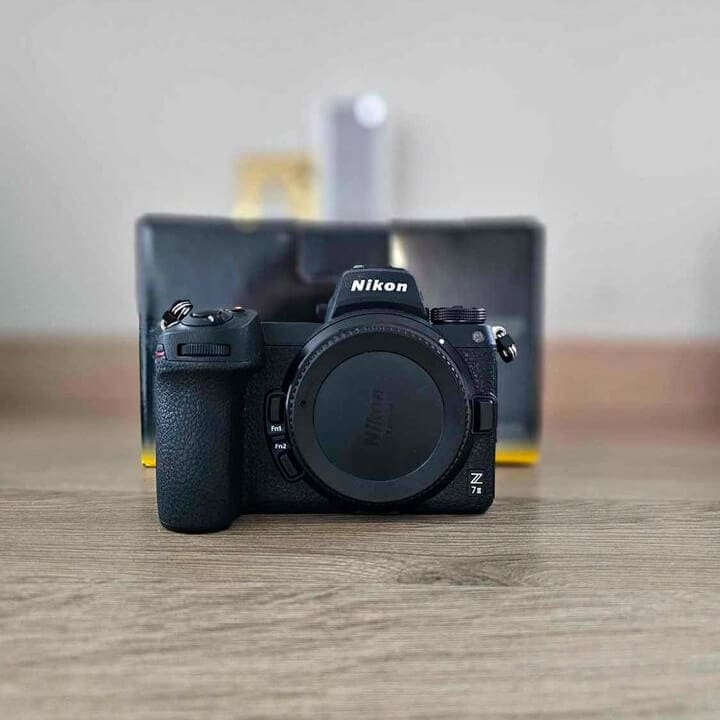




I have the Nikon D750 that I’ve used for milky way photography and it does a great job!
Now I am starting with deep sky astrophotography and plan on using the D750 as well.
What is the best clip on light pollution filters to use with the Nikon D750 for imaging the various objects. I am interested in galaxies and emission nebulae objects to start.
I will be using a sky watcher Esprit 100 APO triplet telescope with the Nikon D750.
Thank you for your help and the article about the Nikon cameras.